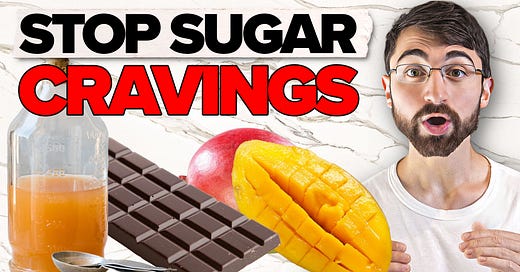The Hidden Gene That Controls Sugar Cravings (And How to Hack It!)
Scientists may have just uncovered a hidden biological quirk that makes some people naturally eat less sugar and stay lean. And there may be a way to hack it...
Scientists may have just uncovered a hidden biological quirk that makes some people naturally eat less sugar and stay lean.
And here’s the kicker: there may be a way to hack it, even if you didn’t draw the winning genetic lottery ticket. So, let’s dive in.
For a video breakdown of these data, click below.
Human ‘Mutants’ Eat Less Sugar
A paper just published in the journal Gastroenterology found that people with mutations in a gene coding for a carbohydrate-digesting protein called “sucrase-isomaltase” had lower intake of added sugar, lower body mass index, and improved metabolic health.
Sucrase-isomaltase is a protein in the intestines with two key functions.
It breaks down sucrose—the sugar found in table sugar and processed foods
It helps digest larger, more complex carbs like starches.
Researchers found that people with a mutation that reduces this protein’s function not only consumed less sugar but also experienced better metabolic health.
The Mechanism: GLP-1 and Acetate
To understand why, scientists created mice with a similar mutation. The result? …
These mice voluntarily ate less sugar when it was mixed into fluids (like soda) or solid foods (like candy bars). Even more interesting, they had a greater GLP-1 response—that’s an anti-obesity hormone that regulates appetite and blood sugar.
The mechanism isn’t fully understood yet, but another key player might be acetate, a molecule that increased in both the mice and humans with this mutation. Researchers suspect this acetate signals the brain and nervous system to boost GLP-1 levels and curb sugar cravings.
A Dose-Response Effect
Returning the human data, the researchers also looked at data on the “liking” foods was studied in 134,766 participants in the UK Biobank. And they found, “a negative linear relationship was also observed [on] food liking and the estimated sucrose content per 100 g of 88 sucrose-containing foods (Figure 1I), indicating that food dislike in [sucrase-isomaltase mutation'] carriers correlates with the amount of sucrose in food.”
So, the more sugar a food contained, the less people with this mutation liked it—compared to those without it.
Hacking the System: Chlorogenic Acid and EGCG
So, what if you weren’t lucky enough to be born with this sugar-blocking mutation? Are you out of luck? Not necessarily.
Because it turns out, there might be a way to replicate this effect—without changing your DNA.
Certain natural compounds found in everyday foods could actually inhibit this sugar-digesting protein and mimic the benefits. And some of them might already be in your kitchen…
Research shows that chlorogenic acid and epigallocatechin gallate (EGCG) can inhibit sucrase-isomaltase at low concentrations.
Chlorogenic acid is found in coffee—especially in green (unroasted) coffee beans, with levels decreasing as beans are roasted.
That means a light roasted coffee may have a healthy advantage over a dark roast. But, honestly, either beats a sugar-laden Frappuccino. How Starbucks Fits more sugar in their Venti Non-Fat Green Tea Frap (87g) as is in 2 Cokes boggles the brain. Oh, and that’s before the whipped cream.
The jump scare to your pancreas aside, chlorogenic acid also present in tomatoes and eggplant. Maybe that’s why the Ratatouille rat was so lean?
Meanwhile, EGCG is abundant in green tea, dark chocolate, and cocoa.
Interestingly, studies link these foods to lower sugar intake and better metabolic health—and while these large population association studies can’t themselves be used to claim causation, when taken in light of this new research on sucrase isomaltase, it raises an exciting possibility of a causative effect.
Conclusion
So, could this be the key to finally controlling sugar cravings? Well, I’ll ask you, have you ever noticed whether coffee, green tea, or dark chocolate – and I mean real Dark Chocolate… none of that 60% ‘soft’ Dark Chocolate – changes how much sugar you want? Comment and let us know.
Community Building Opportunity!
I will produce a video on this research. But I had a thought. Rather than do as usually an just make it, I decided to record my quick breakdown (<5 min, which you can access HERE) and poll people for questions/thoughts/input.
The final version of the video will include at the end answers to some of your questions or community insights that really captured me, with credit. All you have to do is leave a comment and, ideally, share this post. If this experiment goes well… maybe I’ll do more like this.








I probably have this gene. No real sweet tooth here. What I really love is cheese -"sharp" cheese. I now funnel this impulse into eating Pecorino Romano because it is high in Pentadecanoic acid (C15). I also enjoy eating 100% cacao unsweetened chocolate (Baker's brand because ConsumerLabs analysis says it is very low in heavy metals). I know that I am unusual. I also like fermented foods and spicy foods.
Hi Nick, can you clarify what this gene mutation is actually called? I want to check my genome. The article pretty much describes my experience. I dislike sucrose containing foods as a matter of taste. The chart with percentage of food preferences for those individuals is almost identical with mine. I am of European heritage, 98% single origin east European country, the other 2% northern European. I do not have weight issues or glucose disregulation... I wonder if this is why I do not like prepared food or going to restaurants after I moved to the US because I can taste the added sugar and it turns me off. It's been 30 years and I still can't get used to it. My SO just calls me "weird"...